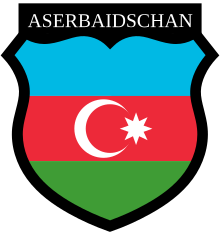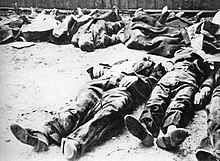
The Waffen-SS was the combat branch of the Nazi Party's paramilitary Schutzstaffel (SS) organisation. Its formations included men from Nazi Germany, along with volunteers and conscripts from both German-occupied Europe and unoccupied lands. It was disbanded in May 1945.

The Waffen Grenadier Brigade of the SS Charlemagne was a Waffen-SS unit formed in September 1944 from French collaborationists, many of whom were already serving in various other German units.

Gottlob Christian Berger was a senior German Nazi official who held the rank of SS-Obergruppenführer und General der Waffen-SS and was the chief of the SS Main Office responsible for Schutzstaffel (SS) recruiting during World War II. At the post-war Nuremberg trials, the Waffen-SS – within which Berger was a senior officer – was declared to be a criminal organisation due to its major involvement in war crimes and crimes against humanity. Berger was convicted as a war criminal and spent six and a half years in prison.

Non-Germans in the German armed forces during World War II were volunteers, conscripts and those otherwise induced to join who served in Nazi Germany's armed forces during World War II. In German war-time propaganda those who volunteered for service were referred to as Freiwillige ("volunteers"). At the same time, many non-Germans in the German armed forces were conscripts or recruited from prisoner-of-war camps.

The Flemish Legion was a collaborationist military formation recruited among Dutch-speaking volunteers from German-occupied Belgium, notably from Flanders, during World War II. It was formed in the aftermath of the German invasion of the Soviet Union and fought on the Eastern Front in the Waffen SS alongside similar formations from other parts of German-occupied Western Europe.

The Dirlewanger Brigade, also known as the SS-Sturmbrigade Dirlewanger (1944), or the 36th Waffen Grenadier Division of the SS, or The Black Hunters, was a unit of the Waffen-SS during World War II. The unit, named after its commander Oskar Dirlewanger, consisted of convicted criminals who were not expected to survive their service with the unit. Originally formed from convicted poachers in 1940 and first deployed for counter-insurgency duties against the Polish resistance movement, the brigade saw service in anti-partisan actions in German-occupied Eastern Europe.
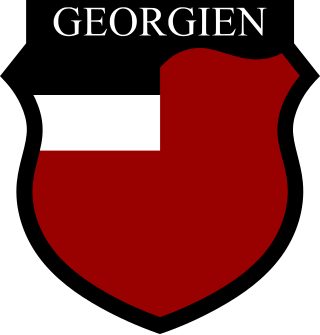
The Georgian Legion was a military formation of Nazi Germany during World War II, composed of ethnic Georgians. It was formed by Georgian émigrés and prisoners of war; its declared aim was the eventual restoration of Georgia's independence from the Soviet Union under Nazi Party's doctrine and supervision. Some components of the Georgian Legion fell under the operational control of Waffen-SS.

The 5th SS Panzer Division Wiking or SS Division Wiking was an infantry and later an armoured division among the thirty-eight Waffen-SS divisions of Nazi Germany. During World War II, the division served on the Eastern Front. It surrendered on 9 May 1945 to the American forces in Austria.

The Walloon Legion was a unit of the German Army (Wehrmacht) and later of the Waffen-SS recruited among French-speaking collaborationists in German-occupied Belgium during World War II. It was formed in the aftermath of the German invasion of the Soviet Union and fought on the Eastern Front alongside similar formations from other parts of German-occupied Western Europe.
Azerbaijani SS volunteer formations were recruited from prisoners of war, mainly from the Soviet Union and the countries annexed by it after 1939. Nazi Germany organised them to fight against the Soviet Union.
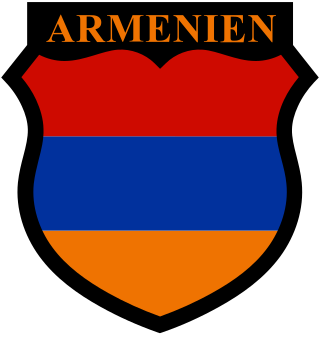
The Armenian Legion was a military unit in the German Army during World War II. It primarily consisted of Soviet Armenians, who wanted to fight the Soviets for an independent Armenia and commanded by General Drastamat Kanayan.

The Wola massacre was the systematic killing of between 40,000 and 50,000 Poles in the Wola neighbourhood of the Polish capital city, Warsaw, by the German Waffen-SS and fellow Axis collaborators in the Azerbaijani Legion, as well as the predominantly-Russian RONA forces, which took place from 5 to 12 August 1944. The massacre was ordered by Heinrich Himmler, who directed to kill "anything that moves" to stop the Warsaw Uprising soon after it began.

The 29th Waffen Grenadier Division of the SS also Legione SS Italiana was an SS formation of Nazi Germany during World War II. It was originally created in the Italian Social Republic in 1943 as the Italian Legion, later renamed to a brigade. The unit was upgraded to division status on 10 February 1945.

During World War II, the Waffen-SS recruited significant numbers of non-Germans, both as volunteers and conscripts. In total some 500,000 non-Germans and ethnic Germans from outside Germany, mostly from German-occupied Europe, were recruited between 1940 and 1945. The units were under the control of the SS Führungshauptamt beneath Reichsführer-SS Heinrich Himmler. Upon mobilisation, the units' tactical control was given to the Oberkommando der Wehrmacht.
The Special Group Bergmann or the Bergmann Battalion was a military unit of the German Abwehr during World War II, composed of five German-officered companies of the Caucasian volunteers.
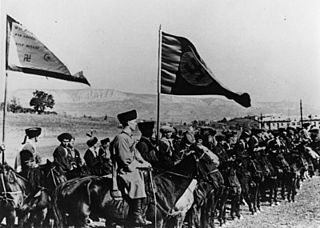
A large number of Soviet citizens of various ethnicities collaborated with Nazi Germany during World War II. It is estimated that the number of Soviet collaborators with the Nazi German military was around 1 million.

The Free Arabian Legion was the collective name of several Nazi German units formed from Arab volunteers from the Middle East, notably Iraq, and North Africa during World War II.
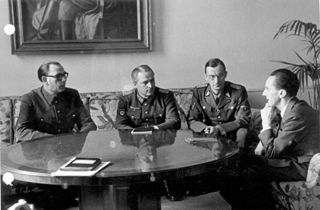
Among the approximately one million foreign volunteers and conscripts who served in the Wehrmacht during World War II were ethnic Belgians, Czechs, Dutch, Finns, Danes, French, Hungarians, Norwegians, Poles, Portuguese, Swedes, Swiss along with people from Great Britain, Ireland, Estonia, Latvia, Lithuania, and the Balkans. At least 47,000 Spaniards served in the Blue Division.

The French SS Volunteer Assault Brigade, most commonly known as the Brigade Frankreich was a unit of the Waffen-SS of Nazi Germany during World War II. It was formed in 1943 after a change in the admission standards of the Waffen-SS allowed Frenchmen to enlist for the first time. After training in Alsace, the brigade served on the Eastern Front before merging with the Legion of French Volunteers Against Bolshevism to form the SS Division Charlemagne.
